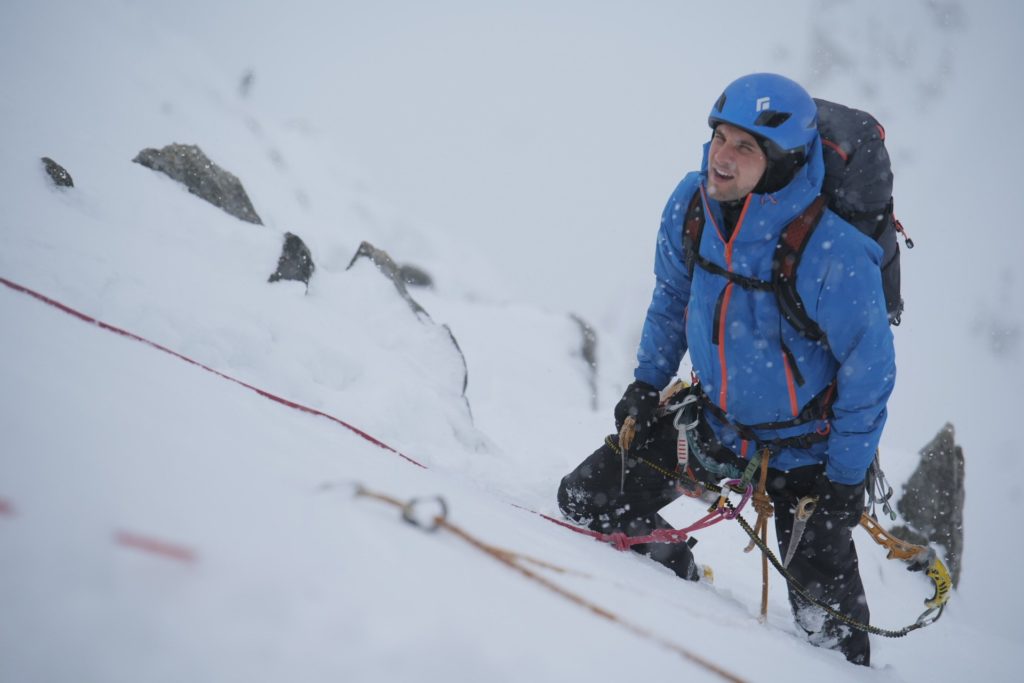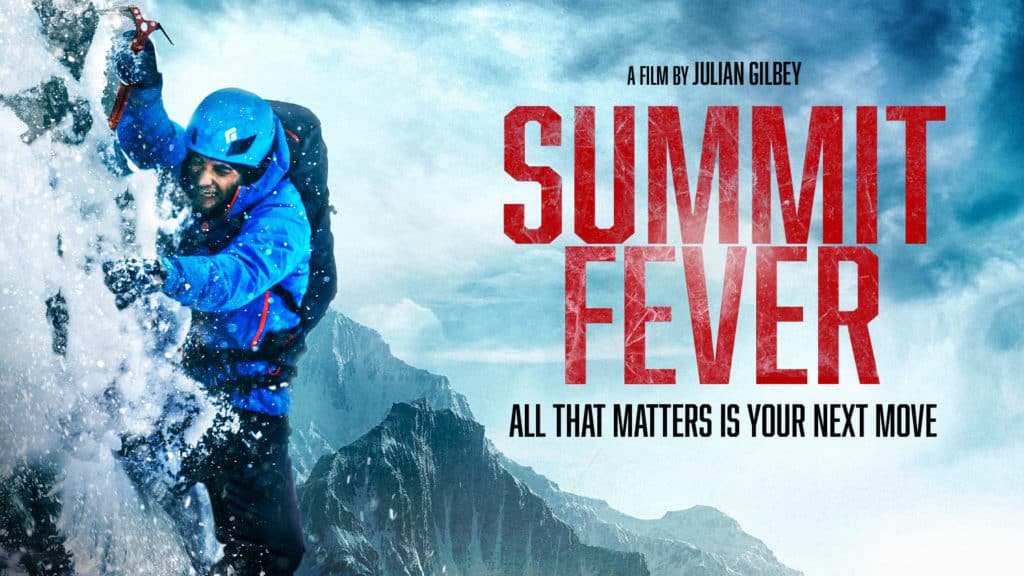Man versus mountain is an age-old cinematic story. Through the years there have been countless tales of survival in the face of adversity as characters get trapped climbing one of the world’s most challenging peaks. From Everest and K2, to treks through the Alps, filmmakers can’t get enough of these stories of man versus nature. The latest filmmaker to tell their version of this story is Julian Gilbey with his new project, Summit Fever.

A keen climber himself, Summit Fever isn’t the first movie on Gilbey’s resume to feature climbing. His 2011 film, A Lonely Place to Die, saw a group of friends climbing in the Scottish Highlands unknowingly cross paths with a dangerous group of criminals. Whilst the climbers were the protagonists and several plot points relied on their ability to scale rock faces, the mountains were only a backdrop to the story being told. Fitting firmly into the crime thriller genre, it couldn’t be more different from what Gilbey has created in Summit Fever. His latest project thrusts climbing front and centre, exploring the concept of Summit Fever. Defined with opening text as the compulsion to reach the summit of a mountain at all costs, the film follows one climber’s journey.
Michael (Freddie Thorp) and his friend JP (Michel Biel) love to climb. Summit Fever opens with the pair on a sun soaked cliff face surrounded by woods. It’s a leisurely climb and the pair discuss their future plans. Whereas Michael is about to join the corporate ladder, JP has lofty aspirations of scaling The Matterhorn and Mount Blanc. The pair separate and Michael begins office life. It’s immediately clear that it’s not for him and when a postcard from JP arrives teasing the fun he’s having, Michael quickly packs up his life and relocates to join him. There he meets ski instructor Isabelle (Mathilde Warnier), as well as a plethora of aspiring mountain scalers, including Leo (Ryan Phillippe).
Summit Fever begins gently. The almost ambling nature of Michael and JP’s first climbing session demonstrates their ability. It immediately proves that they have the confidence and talent to attempt harder terrain and so their Matterhorn ambitions are valid. These people are prepared. It’s also a while into the film before any of the trickier trails are attempted, Gilbey building up the viewer’s confidence in their chances. Time is also spent working on the relationship between Michael and Isabelle; the two are immediately drawn to one another and begin a sweet romance. These moments are all vital in setting the scene and understanding the characters. The audience needs to care about the fates of those on screen and Gilbey’s decision to hold back on their expeditions pays off.
Once the climbing properly begins, Summit Fever takes a turn. Suddenly there is an almost suffocating veil of threat hanging over the film. As Michael and JP become more confident and excited about their attempt, the news is constantly reporting injuries and fatalities caused by the mountain. In reality Mont Blanc is responsible for over 1400 deaths, the Matterhorn over 500. These are stark statistics and highlight the peril that mountain climbers place themselves in. It also begs the question why would anyone want to endanger themselves in such a way, but that is exactly what Gilbey is exploring. What drives a person to dance with death to achieve an almost insurmountable task? Gilbey addresses it via several of the characters, each with their own perspective and it makes for fascinating viewing.

A key element that sets Summit Fever apart from many of its counterparts is that it doesn’t focus on just one trip up the mountain. Films such as K2, Everest, and even Vertical Limit, concern themselves with one central attempt to reach their respective summits. Much of their stories are spent in the grips of survival nightmare. Summit Fever however, follows Michael through a number of climbs. Each is more perilous than the last, slowly increasing both the tension and stakes. An early ascent results in tragedy, the kind that would normally form the bulk of other climbing movies. Here it becomes a plot point for the characters to deal with. After experiencing such intensity it’s hard to understand why further climbs are attempted, but it’s all part of Gibley’s narrative on the drive of climbers to achieve their goal. Once the final excursion is underway, the viewer’s heart is already in their throats.
Striving for authenticity, Gibley did actually film on parts of the mountain. Thorp also committed to learning to climb, with the film having been shot across a number of years, allowing time for the actor to build up his ability. Filming upon and aside one of nature’s deadliest structures is a brave move. Gibley’s boldness pays off, achieving shots that make the jaw drop. Yes it would have been safer to film on a set and use green screen, but that would have diluted the viewing experience. The artificial nature of that construction would have been felt and it’s intrinsic to the success of Summit Fever that the audience feel that they themselves are living the experience. The decision also speaks to Gibley’s own climbing passions, the concept of summit fever mirroring his own determination to get this film made.
With Summit Fever Gibley approaches the traditional mountaineer story from a different angle. Gibley forges his own risky route through a well-trodden path offering a more philosophical analysis. There are elements of the usual ‘man surviving nature’, but the more interesting component is digging into the mindset of Michael and company. Gibley articulates his thoughts effectively and Summit Fever presents a different way of viewing those brave enough to live this white-knuckle life.
Summit Fever
Kat Hughes
Summary
More of a psychological and philosophical study of the drive to climb dangerous mountains, regardless of obstacles, Summit Fever offers some interesting perspectives. If the astute analysis doesn’t do it for you, the breath-taking and authentic vistas are more than enough to sweep you away. A stunning achievement of drive and determination of the team, this is the perfect movie for the armchair adventurer.
Summit Fever is released on Digital HD from Monday 17th October.
Kat Hughes is a UK born film critic and interviewer who has a passion for horror films. An editor for THN, Kat is also a Rotten Tomatoes Approved Critic. She has bylines with Ghouls Magazine, Arrow Video, Film Stories, Certified Forgotten and FILMHOUNDS and has had essays published in home entertainment releases by Vinegar Syndrome and Second Sight. When not writing about horror, Kat hosts micro podcast Movies with Mummy along with her five-year-old daughter.

Latest Posts
-


Home Entertainment
/ 4 days agoUK’s highest-grossing doc ‘Wilding’ sets home entertainment debut
We’ve just heard that the UK’s biggest-grossing documentary Wilding has set a home entertainment...
By Paul Heath -


Film News
/ 4 days agoBack in badness – first trailer for ‘The Bad Guys 2’
The Bad Guys 2 trailer just dropped from Universal Pictures and Dreamworks Animation with...
By Paul Heath -


Interviews
/ 5 days agoLucy Lawless on creating debut documentary ‘Never Look Away’
Lucy Lawless is best known to the world as an actor. She first came...
By Kat Hughes -


Interviews
/ 5 days agoNicholas Vince recounts the journey of ‘I Am Monsters’ from stage to screen
Nicholas Vince is an actor with a history of playing monsters. He is best...
By Kat Hughes













